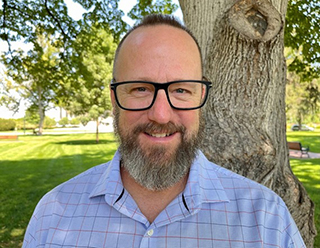| Do the 'rot' thing for Fall tree care
Matthew Perkins, Urban & Community Forestry Manager While Idahoans love trees
and landscaped yards, manicured lawns typically generate large volumes
of yard waste. In fact, most municipalities have too much of it. Because many Idaho cities and counties do not have collection programs
for green waste, it forms a high percentage of trash disposed of in
landfills. Reducing the amount of solid waste entering landfills is
just one important reason for recycling yard waste at home. Your
efforts benefit the entire community, and they ultimately benefit your
landscape.
Because many Idaho cities and counties do not have collection programs
for green waste, it forms a high percentage of trash disposed of in
landfills. Reducing the amount of solid waste entering landfills is
just one important reason for recycling yard waste at home. Your
efforts benefit the entire community, and they ultimately benefit your
landscape. This autumn, plan to recycle leaves instead of raking and bagging them and putting them by the curb to be removed with the trash. Where there is only a light layer of leaves, you can shred the leaves with your lawnmower and leave them on the lawn to decompose. Like lawn clippings, decomposed leaves form water holding humus and add nutrients to the lawn, reducing fertilizer and water needs. When grass clippings or leaves become heavy enough to warrant removal from the lawn, compost or use them directly in your gardens and flower beds instead of sending them to the landfill. Do the “Rot Thing,” and improve your garden soils for better root growth. When pruning this fall, rent a chipper and turn waste wood into valuable mulch that will help to retain water around your trees, reduce weed growth, and make your garden more attractive. If you don’t have a large amount of limbs and branches to chip, organize a neighborhood project and share expenses and labor with your neighbors. Larger diameter branches can be used as firewood to reduce heating costs this winter, or turned into valuable lumber for furniture, fencing, or other wood products. If you have no fireplace, consider giving the wood to a friend or family in need, or selling it and using the money to buy a new tree to plant! Don’t forget to deeply water your trees before winter sets in. A good soaking before frost enters the ground will help the keep the growth the tree put on this year from drying out. It also helps support an actively growing root system. Most root expansion happens after the leaves fall from the tree. Since the roots aren’t busy supporting leaves and tree growth in the fall, growth underground occurs quickly when the top of the tree is dormant. If we have a dry, warm winter, water once a month throughout the season. For more information about tree care, pest identification, landscaping pro tips and more, visit https://www.idl.idaho.gov/urban-forestry. Matthew Perkins serves as the Urban & Community Forestry Program Manager for the Idaho Department of Lands. Matthew and his team provide technical and educational assistance to help citizens and professionals with a wide range of actions, from tree ordinance creation to urban forestry program development, helping our communities use trees and forest canopies strategically. |